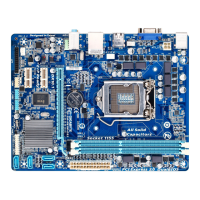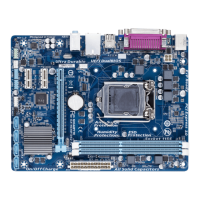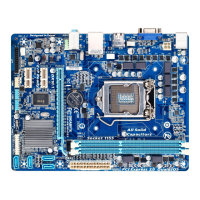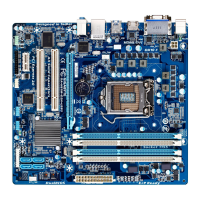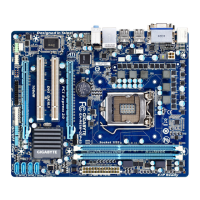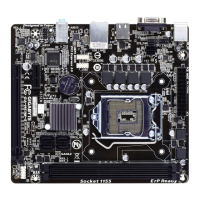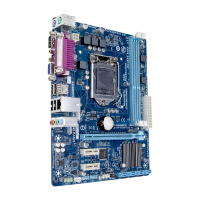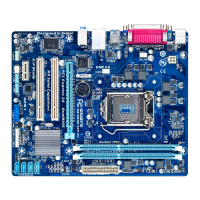Do you have a question about the Gigabyte GA-H61M-DS2V and is the answer not in the manual?
States conformity with FCC rules for Class B digital devices, including operating conditions.
Indicates compliance with EU directives like EMC and LVD, ensuring product safety and performance.
Guide to finding the motherboard revision number on the board itself.
Lists included items in the product package, such as cables and accessories.
Essential safety and handling guidelines before installing hardware components.
Lists detailed hardware components and capabilities of the motherboard.
Details supported CPUs, chipset, and DDR3 memory specifications.
Describes integrated graphics, audio codec, and Gigabit Ethernet LAN.
Covers PCI Express slots, SATA connectors, and USB ports.
Details internal headers and the ITE IT8728 I/O controller.
Explains system monitoring and key BIOS functionalities.
Step-by-step guide for installing the CPU into the socket.
Identifies alignment keys and notches on the socket and CPU.
Instructions for installing DDR3 DIMM modules.
Explains how to set up dual-channel memory for better performance.
Guide for installing expansion cards into PCI Express slots.
Identifies and explains all external ports on the motherboard.
Details the functionality of USB and PS/2 ports.
Describes the analog and digital video output ports.
Details the Ethernet port and audio connections.
Identifies and explains internal motherboard headers.
Lists and labels key internal connectors like ATX, CPU_FAN, F_PANEL.
Details the 24-pin ATX and 4-pin ATX_12V power connectors.
Shows pin assignments for the 4-pin 12V CPU power connector.
Shows pin assignments for the 24-pin ATX main power connector.
Explains the 4-pin CPU_FAN and SYS_FAN headers for cooling.
Details the SATA2 connectors for storage devices.
Describes connections for power/reset switches, LEDs, and speaker.
Shows pinout for MSG/PWR LED, Power Switch, Speaker, HDD LED, Reset, CI.
Details connections for HD and AC'97 audio modules.
Explains connections for optional USB brackets.
Instructions for clearing BIOS settings using the jumper.
Information about the CMOS battery and its replacement.
Describes the initial GIGABYTE logo screen that appears during boot.
Overview of BIOS setup navigation and main menu items.
Lists main BIOS sections like M.I.T., System, BIOS Features, Peripherals.
For CPU/memory frequency, voltage, and health status.
Displays current BIOS version, clock speeds, and temperatures.
Allows adjustment of CPU and memory clock ratios and frequencies.
Options for CPU core ratio, Turbo Boost, and thermal management.
Settings for CPU clock multiplier and operating frequency.
Details settings like PLL Overvoltage, Turbo Boost, Power Limit.
Options to enable/disable CPU cores and Hyper-Threading.
Covers EIST and PROCHOT functions for power efficiency.
Options for memory multiplier, frequency, and timing.
Options for performance levels and DRAM timing configuration.
Settings for memory channel and rank interleaving.
Detailed manual configuration of memory timings.
Adjustments for CPU Vtt and DRAM voltages.
Displays system voltages, temperatures, and fan speeds.
Details temperature, voltage, and fan speed monitoring and control.
Options for managing CPU and system fan speeds.
Provides information on motherboard model, BIOS version, and system language.
Configuration for Isochronous Support.
Configuration of system date, time, language, and access levels.
Options for boot order and system startup settings.
Specifies the order devices are checked for booting.
Configures boot order for storage devices and startup behavior.
Settings for Intel Virtualization Technology and Execute Disable Bit.
Options to set Administrator and User passwords for BIOS access.
Configuration of onboard devices like LAN, SATA, USB, and Audio.
Settings for LAN PXE, SATA controllers, and USB controllers.
Configuration for onboard audio and initial display selection.
Settings to manage system power states and energy saving.
Configures system behavior after power loss and keyboard wake-up.
Manages system sleep states (S1, S3) and wake-up events.
Covers ErP, High Precision Timer, and power button behavior.
Options for saving/discarding BIOS changes and loading defaults.
Details saving changes, exiting without saving, and loading defaults.
Allows saving/loading BIOS profiles and direct boot selection.
Guide on installing drivers from the motherboard disk after OS installation.
Standard legal disclaimers and copyright information.
Information on RoHS and WEEE directives for responsible disposal.
| ECC | No |
|---|---|
| Non-ECC | Yes |
| Memory voltage | 1.5 V |
| Memory channels | Dual-channel |
| Memory slots type | DIMM |
| Number of memory slots | 2 |
| Supported memory types | DDR3-SDRAM |
| Maximum internal memory | 16 GB |
| Supported memory clock speeds | 800, 1066, 1333 MHz |
| Supported memory module capacities | 1GB, 2GB, 4GB, 8GB |
| System bus rate | 5 GT/s |
| Processor socket | LGA 1155 (Socket H2) |
| Processor manufacturer | Intel |
| Compatible processor series | Intel Core i3, Intel Core i5, Intel Core i7 |
| Maximum number of SMP processors | 1 |
| Number of SATA II connectors | 4 |
| USB 3.2 Gen 1 (3.1 Gen 1) connectors | 0 |
| Headphone outputs | 3 |
| USB 2.0 ports quantity | 6 |
| Audio chip | Realtek ALC887 |
| Cooling type | Passive |
| Component for | PC |
| Power source type | ATX |
| Motherboard chipset | Intel® H61 |
| PC health monitoring | CPU, FAN, Temperature |
| Audio output channels | 7.1 channels |
| Motherboard form factor | micro ATX |
| Supported storage drive interfaces | SATA II |
| Graphics card | HD Graphics |
| OpenGL version | 3.2 |
| DirectX version | 11 |
| Maximum resolution | 1920 x 1200 pixels |
| Maximum graphics card memory | 1696 MB |
| Parallel processing technology support | Not supported |
| PCI Express slots version | 2.0, 3.0 |
| Cables included | SATA |
| LAN controller | Realtek RTL8111F |
| Networking features | Gigabit LAN |
| Ethernet interface type | Fast Ethernet, Gigabit Ethernet |
| BIOS type | EFI AMI |
| ACPI version | 2.0a |
| BIOS memory size | 32 Mbit |
| Depth | 174 mm |
|---|---|
| Width | 244 mm |
